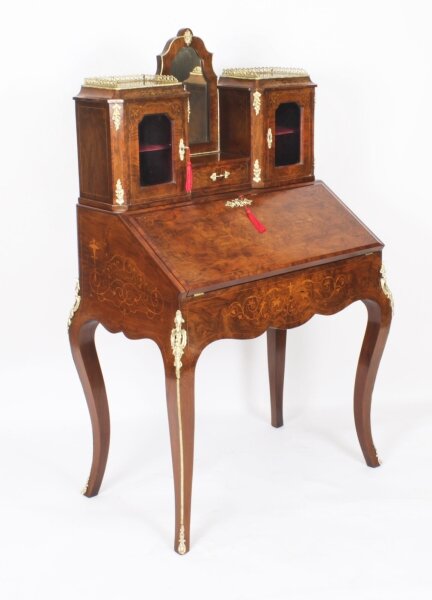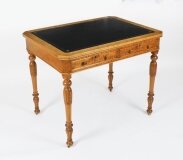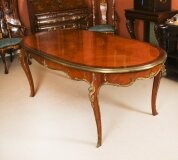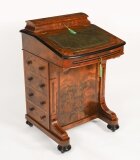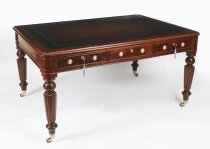A bonheur du jour (in French, bonheur-du-jour, meaning "daytime delight") is a type of lady's writing desk. It was introduced in Paris by one of the interior decorators and purveyors of fashionable novelties called marchands-merciers about 1760, and speedily became intensely fashionable.
The bonheur du jour is always very light and graceful, with a decorated back, since it often did not stand against the wall but was moved about the room. Its special characteristic is a raised back, which may form a little cabinet or a nest of drawers, or open shelves, which might be closed with atambour may simply be fitted with a mirror. The top, often surrounded with a chased and gilded bronze gallery, serves for placing small ornaments. Beneath the writing surface there is usually a single drawer, often neatly fitted for toiletries or writing supplies.
Early examples were raised on slender cabriole legs; under the influence of neoclassicism, examples made after about 1775 had straight, tapering legs. The marchand-mercier Simon-Philippe Poirierhad had the idea of mounting bonheurs du jour with specially-made plaques of Sèvres porcelainthat that he commissioned and for which he had a monopoly; the earliest Sèvres-mounted bonheur du jours are datable from the marks under their plaques to 1766-67. The choicer examples of the time are inlaid with marquetry or panels of Oriental lacquer, banded with exotic woods, with gilt-bronze mounts.
By the mid-1770s the bonheur du jour was being made in London, where it was simply called a "lady's writing-desk".
Figured Walnut and Burr Walnut (often referred to as Burl Walnut) were considered as the most attractive varieties of Walnut. Burr Walnut veneer was taken from the specific part of the tree where ‘growths’ sprouting smaller branches and/ or roots would occur. As these ‘growth’ areas were limited in both occurrence and size, larger veneers were hard to source and often on bigger furniture (tables, desks, bureaus, cabinets etc), these veneers would have to be carefully joined by matching up the pieces or blending them together.
Ormolu (from French 'or moulu', signifying ground or pounded gold) is an 18th-century English term for applying finely ground, high-carat gold in a mercury amalgam to an object of bronze.The mercury is driven off in a kiln leaving behind a gold-coloured veneer known as 'gilt bronze'.
The manufacture of true ormolu employs a process known as mercury-gilding or fire-gilding, in which a solution of nitrate of mercury is applied to a piece of copper, brass, or bronze, followed by the application of an amalgam of gold and mercury. The item was then exposed to extreme heat until the mercury burned off and the gold remained, adhered to the metal object.


